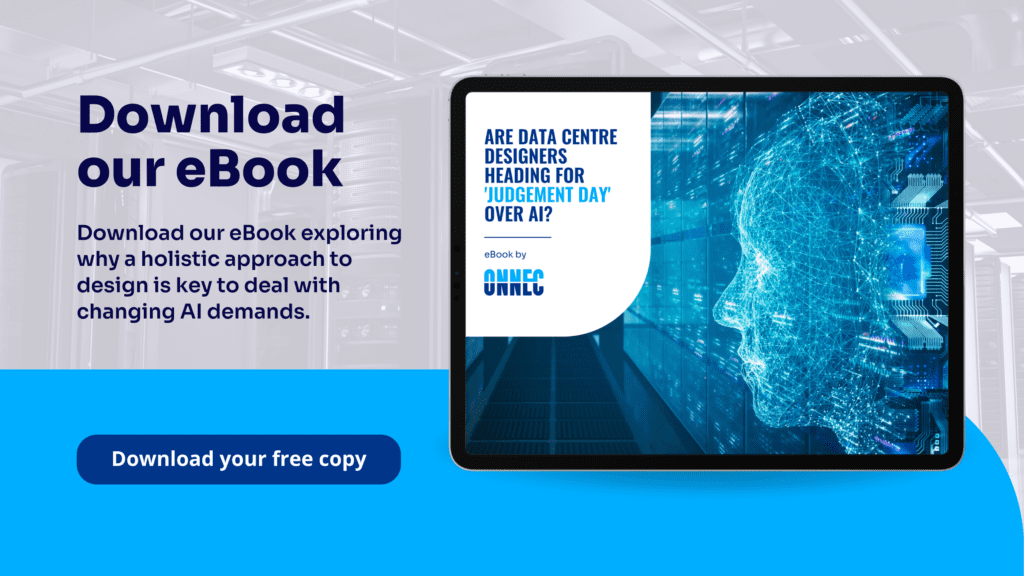
Assessing the consequences of cutting corners in Data Centre Design
By Niklas Lindqvist, General Manager Onnec Nordics for Intelligent Data Centres Issue 57
As data centres evolve to incorporate AI and emerging technology into their operations, it is crucial that data centre infrastructure can support such developments. In the latest issue of Intelligent Data Centres, Niklas Lindqvist, Onnec Nordics General Manager, explores the consequences of cutting corners when it comes to data centre design and how a holistic approach can help to future-proof data centres.
What are the key areas that AI will change in data centre design?
AI has transformed data centre design requirements. The adoption of AI applications is pushing data centres to evolve, requiring specialised infrastructure that caters to the unique demands of Machine Learning algorithms. Three key areas will need to evolve to keep up with increasing worldwide AI spending.
First and foremost, there’s a huge increase in the appetite for power. AI computation relies heavily on specialised processors, particularly GPUs (Graphics Processing Units) and DPUs (Data Processing Units), which draw considerably more power, emit more heat and occupy more space compared to traditional CPU-powered racks.
Secondly, this means data centres must invest in robust power infrastructure and devise efficient cooling solutions to prevent overheating to combat relentless energy consumption. While air cooling still has a role to play, it often falls short in cooling AI hardware efficiently. Often, liquid cooling is the preferred option for high-performance chips, offering superior cooling and potential cost benefits.
Finally, cabling – often the ‘forgotten child’ of design – is also habitually overlooked and under-budgeted. As with power connections and cooling systems, cabling is embedded infrastructure. These are all built into the structure of a data centre complex. This means systems can be extortionately expensive to replace, if not outright economically impossible, leading to huge problems down the line.
What are the consequences of cutting corners in data centre design?
With new business technologies – particularly AI – emerging at a rapid pace, data centres are facing an unprecedented surge in demand. In response, many operators may be tempted into shortcuts as a way of reducing costs. While choices like these may provide immediate savings, they unknowingly plant the seeds for significant long-term costs and problems, such as outages or downtime.
When future-proofing data centres, designers cannot afford to look at the individual pieces of the puzzle – from power to cabling – in isolation. Design decisions can have a lasting impact on the business landscape.
Once data centres are operational, changing these design aspects is costly and potentially irreversible. As a result, cutting design corners can lead to enduring issues like frequent downtime and limited scalability, and recognising this can help operators plan for future design needs and the required infrastructure.
What areas of data centre design are often overlooked?
Historically, data centre design has revolved around power and cooling requirements, while areas such as cabling tend to be relegated to a lower priority. However, this oversight can lead to serious issues during future upgrades, including tangled and disorganised connections. When cabling is poorly laid out, it often requires complete removal and reinstallation – which leads to additional costs and downtime.
For operators prioritising cost savings, opting for subpar cabling quality is also counterproductive as it will require premature replacement, again incurring extra costs. On top of this, low-quality cabling makes it considerably more difficult to pinpoint issues, which means operators spend more time and cost on troubleshooting. Just as a second-rate audio cable can waste the quality of a top-end Hi-Fi, poor cabling can squander the value of high-performance data centre hardware. High-quality cabling is vital if operators want to avoid expensive downtime, productivity losses and unexpected costs.
Are these issues exclusive to new data centre designs, or do they also affect existing data centres undergoing upgrades?
Whether companies are designing their data centre from the ground up or looking to upgrade an existing one, investing in high-quality cabling allows data centre operators to future-proof for AI and whatever technology comes next. This allows operators to benefit from long-term cost savings, supports high data throughput, reduce downtime and enhances flexibility. Neglecting to invest in areas such as cabling can cause headaches for operators, regardless of whether they’re constructing a brand-new data centre or enhancing an existing one.
Data centre operators and managers must prioritise design and invest in highquality cabling and components from the start. Giving data centres the flexibility needed to adapt is vital because designers won’t know what the new hardware requirements will be in two or three years. This proactive strategy acts as a shield against frequent downtime, scalability limitations and unexpected costs down the road.
How can a holistic approach to design help future-proofing data centres for AI and other emerging technologies?
Operators must adopt a holistic approach to data centre design and leave the traditional siloed process behind. This requires planning for future growth and accommodating rising AI and tech demands, without significant structural alterations.
First, operators must think beyond immediate needs and consider the long-term vision for the data centre. By stepping back and adopting a strategic perspective, operators can ensure that design discussions – on aspects like power or cabling – are based on anticipated usage.
This requires developing a shared vision between all stakeholders, so teams are aligned on a common design end goal. When these decisions are made collectively – drawing on the expertise of various teams – operators are in a much better position to create a well-rounded and adaptable facility.
On top of this, designing data centres with modularity in mind minimises the need for frequent infrastructure changes. As predicting hardware requirements in the fast-evolving tech landscape is challenging, modular design offers the agility to adapt to unforeseen developments. AI’s influence also extends beyond design requirements; it can act as a potent support system, empowering operations teams to efficiently manage data centres, extend their lifespan and boost sustainability. By integrating AI seamlessly into the design process, data centres are ready to evolve with the ever-changing landscape of technological advancements.
To learn more about a holistic approach to data centre design and the wide-ranging impact of AI on data centres, download our free eBook today.
About Intelligent Data Centres
Intelligent Data Centres is a technology publication from the Lynchpin Media Group, that publishes news and research about the DC industry.
www.intelligentdatacentres.com

